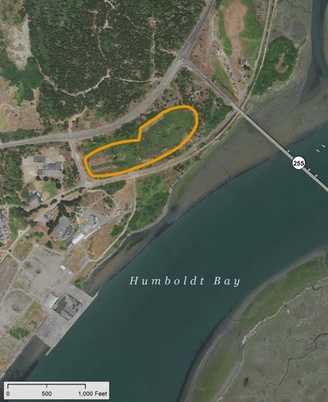
The Harbor District’s new in-house dredge, purchased in 2014.
PREVIOUSLY:
- YOUR WEEK IN OCEAN: Dredge Dumping Redux! Samoa Beach Proposed for Sludge Disposal Once Again
- CITY OF EUREKA: We Gotta Dredge the Marinas, and Dumping the Spoils on the Beach is The Least Environmentally Impactful Option on the Table
- EPA Rejects Eureka/Harbor District’s Plan to Dump Dredge Spoils on the Beach
It has been a decade since Eureka’s public marina and the Woodley Island Marina were dredged to remove the sediment that accumulates on the floor of Humboldt Bay, and with the heavy rainfall over the last two years that sediment has built up to the point where boats are left nestled in mud, unable to leave the docks for hours at a time. Roughly 200,000 cubic yards of sediment needs to be removed.
Until late last week, the City of Eureka and the Humboldt County Harbor, Recreation and Conservation District, the two agencies responsible for performing maintenance dredging, planned to dump the dredge spoils on a beach along the Samoa Peninsula, as they have for years.
Late last week, though, the Environmental Protection Agency rejected that plan, sending local officials back to the drawing board. This caused much consternation for Miles Slattery, director of Eureka’s Parks and Recreation Department, who argued adamantly that beach disposal would be the least environmentally damaging option available.
But officials with the EPA told the Outpost in an email that local decision-makers were instructed nearly 20 years ago to make alternate plans for the dredge spoils, and they were reminded again in 2007.
EPA public affairs officer Bill Keener said beach dumping is not allowed because the sediment from the bay is primarily composed of fine-grain silts and mud, making it inappropriate for the surf zone on sandy beaches. Back in 1995 the EPA designated a disposal site for Humboldt Bay dredge spoils three miles offshore. It’s called the Humboldt Open Ocean Disposal Site (HOODS).
“However, the 1998 permit for the Harbor’s dredging was inappropriately issued by the [U.S. Army] Corps of Engineers allowing continued surf-zone disposal,” Keener explained. “[The] EPA, the Corps, and the Coastal Commission all agreed to allow that permit to stay in force, in order to give the Harbor time to plan (and budget) for a different dredging operation after the permit expired in 2008.”
So when the City and Harbor District last dredged the marinas, in 2007, it was considered the last use of that 1998 permit. Keener said regulators were unambiguous on this point.
“[The] EPA (as well as the Army Corps and the California Coastal Commission) made it clear both in 1998, and at the time of the final dredging under the old permit in 2007, that the permit could not be renewed the same way.”
Yet this beach method of dredge disposal was incorporated into the Harbor District’s 2007 Humboldt Bay Management Plan, with no mention that regulatory agencies had forbidden future beach dumping.
After the 2007 dredging, the Coastal Commission explicitly required staff from the City and the Harbor District to submit “annual reports detailing the efforts undertaken during the previous calendar year to prepare for future maintenance dredging in a manner that discontinues the past practice of nearshore disposal of dredged materials.”
Slattery explained in a press release back in March that, due to staff turnover in 2012-13, “there was an oversight of the permit condition.” No reports were issued over the past four years.
Harbor District Executive Director Jack Crider told the Outpost via email that District staff has been working to develop upland disposal options and also shorten the seven-to-10-year dredging cycles.
“Every upland site has been challenged with environmental restrictions but we are committed to develop these sites that will accommodate annual maintenance dredging,” Crider said.
He also disputed the EPA’s claims to some extent, saying, “Coastal Commission was the only agency that clearly stated 2007 that no beach disposal would be allowed until all other options have been exhausted.”

Samoa Lagoon upland disposal site. | Image from a PowerPoint presentation given by the City and Harbor District earlier this week.
The current plan, Crider said, is to use the Samoa Lagoons site (pictured) to remove debris and sediment from the public marina and then “pump the decant water to the [former] Pulp Mill’s water treatment plant prior to discharge back to the Bay or Ocean.”
This method will not be sufficient to handle all 200,000 cubic yards of sediment that need to be removed from the two marinas, but it should be enough to make them functional again until another solution is found.
The EPA is encouraging local officials to come up with a beneficial reuse for the dredged materials, such as enhancing or restoring local marshes, something Slattery said the City is indeed pursuing. Failing that, the agency encourages use of the HOODS offshore disposal site, which would require dredging into flat-bottom boats and hauling the spoils three miles offshore, an option local officials say is cost-prohibitive.
But the question remains why the EPA wasn’t consulted earlier.
“We first heard that the Harbor was again interested in pursuing surf-zone disposal last week (April 26),” Keener said, “when the Harbor’s consultant emailed EPA a copy of presentation slides that it was planning on using at an interagency meeting scheduled later that day.”
We emailed Slattery this morning asking for more information but didn’t hear back by the time this post was published.
CLICK TO MANAGE